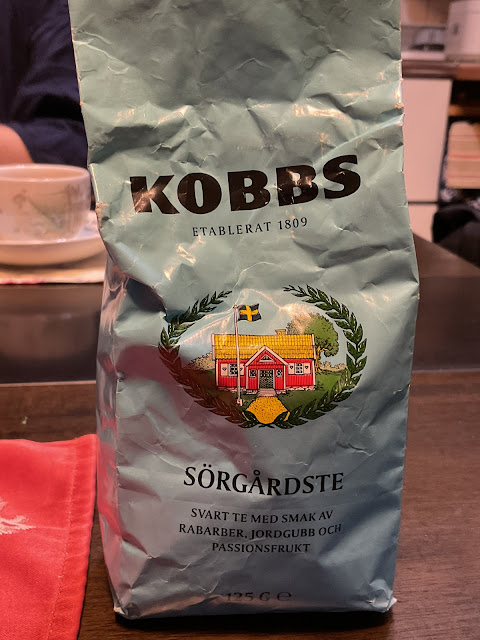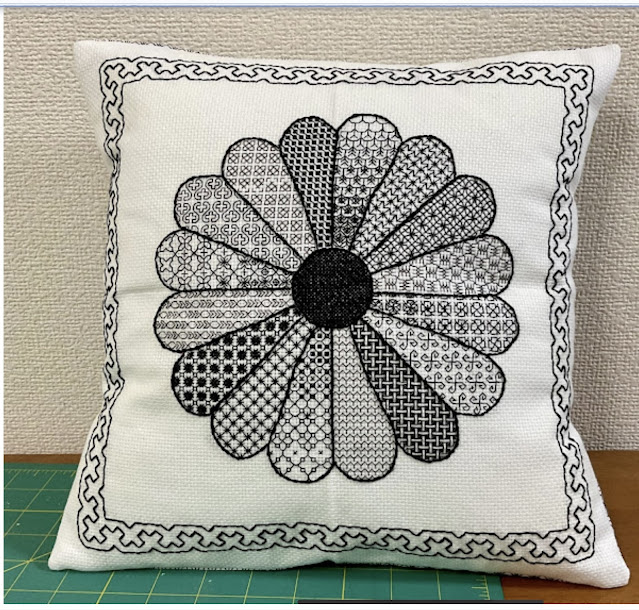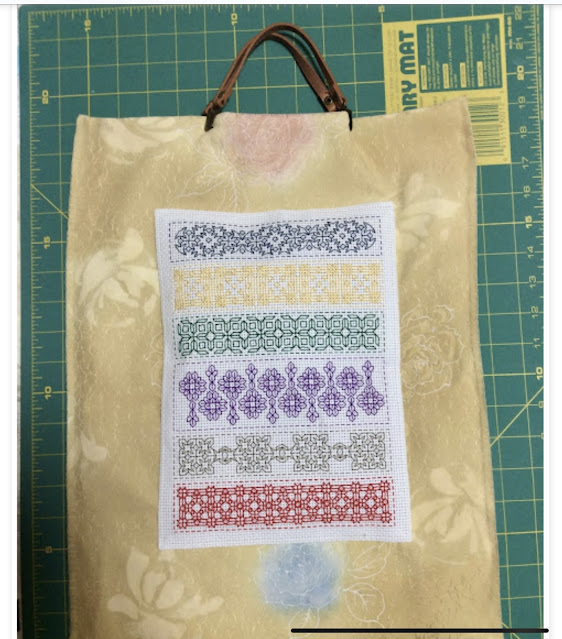Pages
- Home
- Kumano Kodo Trip
- Japanese Festivals
- Japanese Castles
- Stitching Finishes 2025
- Stitching Finishes 2024
- Stitching Finishes 2022
- Stitching Finishes 2021
- Stitching Finishes 2020
- Finish It in 2019
- Stitching Finishes 2018
- Stitching Finishes 2017
- Stitching Finishes 2016
- Stitching Finishes 2015
- Stitching Finishes 2014
- Stitching Finishes 2013
- Stitching Finishes 2012
- Smalls Stitch A Long 2018 - 2019
- Smalls Stitch A Long 2014 - 2017
- 6 & 6 in 2018
- 17 in 2017
- Take A Stitch Tuesday
- English Paper Piecing Projects
Thursday, October 31, 2024
Wednesday, October 30, 2024
Work In Progress Wednesday
Four Seasons Kogin progress
Toki, who blogs at 私がめがねをかけるとき, and I are both stitching this kogin piece. (She blogs in Japanese, but there is a translation button on the top left under the title, if you don’t read Japanese.) Check out her progress!
I have added the tea pots to my summer section. I hope to have the centers of the teapots filled in by next week.
Rapunzel Blackwork progress
Tuesday, October 29, 2024
Halloween Stitching
I have a lot of ornaments and Christmas stitching, but not so much for the other holidays. I have two items for Halloween, and even though Halloween is an American holiday, I pull out these two things every October. I do it because I like the stitching, not so much because I like Halloween. Do you decorate with Halloween stitched items?
I’m linking with Jo’s Halloween Spooky Link-up 2024. Please check out the other Halloween stitching and decorations
Monday, October 28, 2024
Halloween Party Lunch
Yesterday I went to a Halloween Party Lunch. My friend prepared many delicious Japanese autumn dishes.
This is Oden and it is a very popular dish. I’m not sure what all is in it.
This is how Wikipedia describes it:
Oden is a type of nabemono consisting of several ingredients such as boiled eggs, daikon or konjac, and processed fishcakes stewed in a light, soy-flavored dashi broth. Oden was originally what is now commonly called miso dengaku or simply dengaku; konjac or tofu was boiled and eaten with miso.
Japanese sweet potatoes are in the foil. The rice dish has chestnuts in it. The blue and red and yellow cups have pumpkin soup in them.
This is my plate.
We ate and talked and I had a very good time!
Sunday, October 27, 2024
Today is Election Day in Japan
The upcoming November 5th election in the US has been crazy chaos for ages. I feel like the country is on the edge of a cliff and it is frightening. Contrast that with the quiet orderly election being held today in Japan.
Between 1885 and 1947, the prime minister was chosen by the Emperor. Since 1947, the prime minister has been chosen in the “designation election of the prime minister” in the National Diet (legislature). The voters don’t choose the prime minister directly.
Prime Minister Ishiba
Previous Prime Minister Kishida recently resigned and Shigeru Ishiba was chosen to take over the beginning of October. Eight days later, he called for a snap election of the lower house, which is being held today. Candidates have about two weeks to campaign. They put their pictures on giant boards in every neighborhood and have loud speakers on vans that drive around making announcements. This lasts two weeks vs. about two years and millions of dollars for campaigning in the US.
I read in the Yomouri Shinbun online news that only about 60% of eligible voters have voted in the last three national elections in Japan. The article didn’t say if that included during the pandemic. That seems like a low voter turn out, but I don’t know how that compares with other countries. I’ve been told by my students that elections are always held on Sundays and that voters hand write the name of the candidate in Kanji on special paper. No matter who wins today's election, I feel sure there will not be a January 6th type insurrection in Japan.
Saturday, October 26, 2024
Stitch Group Wednesday
Our usual stitching day is Sunday, but sometimes we also meet on weekday afternoons. They call these smaller weekday get togethers “private lessons”. This week, we worked on our current project, trying out ideas and getting opinions from the other stitchers, and practicing stitches for clouds.
The hostess served some delicious Swedish Tea.
Friday, October 25, 2024
Foreign University Student Missing in Japan
Worm, a 21 year old German University student, who came to Japan for sightseeing during his school vacation on September 21st, has been missing since October 10th or 11th. He was in Tokyo for the first part of his trip, then had hotel reservations in Wakayama from September 30th to October 10th. He last contacted family on October 10th. His passport and wrist watch were found in a public restroom near Wakayamashi Station on October 11th and security camera footage appears to show him in that area around 8 pm on the same date. The Mainichi News reports that 40 items, including a smartphone, belonging to Worm were found near a river in Wakayama City.
His University classes started on October 12th and when he didn’t attend classes, he was reported missing on October 16th.
He is 173 cm tall with blond hair and has a medium build. Anyone with information is asked to contact the Wakayama Prefectural Police Headquarters at 070-423-0110.
This is quite a mystery. I wonder if something bad happened or if he voluntarily went missing. Japan is very safe and I often travel alone, but I have heard about tourists going missing from time to time. Being without a passport makes me think he didn’t voluntarily go missing. I will continue to search the news to try to find out what happened.
What do you think?
Thursday, October 24, 2024
Blackwork
Last week I pulled out the Rapunzel project that I reported on yesterday. It made me remember how much I like blackwork.
(Information about blackwork can be found at this Royal School of Needlework link .)
Here are some of my other blackwork pieces.
Checkerboard by designer Marion Scoular
Ojimi by designer Carolyn Standing Webb
Blackwork Alphabet by designer Lorraine Banniskis.
Queen Elizabeth I by designer Gaye Ann Rogers (sleeves are blackwork)
Blackwork fish
Blackwork Rose by designer Carol Algie Higginbotham
Blackwork pheasant, peacock, and kingfisher by designer Tanja Berlin
Box of Delights by designer Elizabeth Almond
Daffodil ornament by Marion Scoular
Ornaments
Miniature pillows
Blackwork Sampler (sorry, I didn’t record the designer)
Blackwork sampler from a magazine (again, I didn’t record the designer)
Acorn design
Ornaments
Lavender Sachet
Wednesday, October 23, 2024
Work In Progess Wednesday
Four Seasons Kogin Progress - continuing with summer.
Toki, who blogs at 私がめがねをかけるとき, and I are both stitching this kogin piece. (She blogs in Japanese, but there is a translation button on the top left under the title, if you don’t read Japanese.) Check out her progress!
Rapunzel Blackwork Progress (Marion Scoular)
I’ve worked on this one a lot this week, after not working on it at all in 13 years!
Tuesday, October 22, 2024
Autumn Foliage Forecast in Japan
Are the leaves changing color where you live? I’ve noticed some leaves falling, but no beautiful colors here, yet.
Monday, October 21, 2024
Stitch Group Sunday
The Stitchers met yesterday. We were talking a lot and I didn’t remember to take many pictures. One of the topics was Pandas.
Here is the progress they made.
We will meet on Wednesday afternoon this week because we like this project so much!
Tea time. (You probably wish you could join us).
Sunday, October 20, 2024
Yakuza Dog Poop Arrest
Everyone knows the yakuza don’t take any crap. You can’t make this stuff up.
A 57 year old man, who is a member of the Yamaguchi-gumi yakuza family (Japanese mafia family), was arrested in Asahikawa City Hokkaido. My first thought was - a member of a crime family getting arrested is not unusual news. But wait, he was arrested for violation of the waste management law. So what did he do, you ask? The police say that on at least two occasions, he failed to clean up his dog’s poop while out for a walk. The man denies the poop came from his dog, but with surveillance cameras and DNA results from the poop and the dog, the police think they have a strong case.
I have never heard of anyone being charged with this crime before, but the people I see walking their pets always carry a clean up kit. Is it possible that this is more about getting a yakuza member than arresting someone for a nuisance crime? What do you think?
Saturday, October 19, 2024
Mishima Shrine, Emmei-ji Temple, and Sushi
After visiting Yamanaka Castle ruins, and taking the bus back to Mishima, I got off the bus at Mishima Shrine. Even though I have been here before, it is still interesting to visit again.
Behind the shrine area, I saw this little deer zoo that I hadn’t seen on previous visits.
Just by luck, I came across Emmei-ji Temple, which seems to be the dog temple.
This is the google translate of the page above. It didn’t translate the story exactly right.
I ate sushi dinner at this restaurant, across from the train station. Many restaurants in Japan have pretend food, possibly made of wax, to show what they serve. I had a sushi plate, but don’t have a photo of it. It was very delicious.
Another good day in Japan.
Subscribe to:
Comments (Atom)
































































